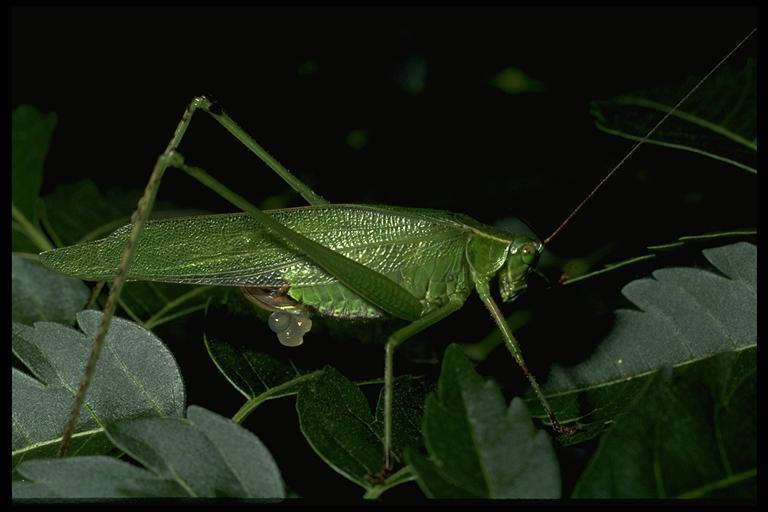
A “false” katydid, Scudderia sp. (Orthoptera: Tettigoniidae), adult. Photo by Drees.
Common Name: Katydid
Scientific Name: Scudderia sp.
Order: Orthoptera
Description: Tettigoniids are predominantly medium to large (1 to 2-1/2 inches long), winged or short-winged, green to brownish insects with long, hair-like (filamentous) antennae, and hind legs modified for jumping. Males are capable of generating sound and do so by rubbing their wings together (stridulating). Females hear them with an “ear” (tympanum-covered auditory structure) at the base of each front leg’s second segment (tibia). Most adult females possess a sword-shaped egg-laying structure (ovipositor).
Grasshoppers in the family Acrididae have short antennae and the auditory structures (tympanum) are located on the sides of the first abdominal segment.
Life Cycle: Depending on species, females insert oval, flattened eggs into bark of trees, on twigs or along the edges of leaves in the fall. Wingless nymphs hatch in the spring and develop through several stages (instars) as wing pads develop. Adults of most species have fully developed, functional wings. One generation per year is produced.
Habitat, Food Source(s), Damage: Most katydids and long-horned grasshoppers are general plant feeders, consuming foliage, stems, flowers, fruit of trees, weeds, and crops. Some species of “false” katydids of the genera Microcentrum and Scudderia (Tettigoniidae, Phaneropterinae) produce a double row of flattened, grayish-brown, 1/4 inch oval, overlapping eggs on twigs in the fall and feeds on orange (citrus) leaves during the summer. Meadow grasshoppers, Conocephalus spp., are numerous in wet grassy meadows and rice fields and feed on pollen. However, they are seldom numerous enough to cause serious plant injury. A few species are predatory on other insects. Wings of adults of some species appear leaf-like, allowing katydids to hide in foliage.
Pest Status: Most feed on leaves and tissues of various plants; a few are predaceous. If held improperly they can bite. Katydids are named for the sounds resembling, “Katy-she-did” or “Katy did, Katy didn’t,” produced by males of some species (e.g., the northern true katydid, Pterophylla camellifolia (Fabricius) (Pseudophylinae). Each species has a unique song.
For additional information, contact your local Texas A&M AgriLife Extension Service agent or search for other state Extension offices.
Literature: Borror et al. 1989; Drees et al. 1995; Helfer 1972; Metcalf et al. 1962; Swan and Papp 1972; Westcott 1973.